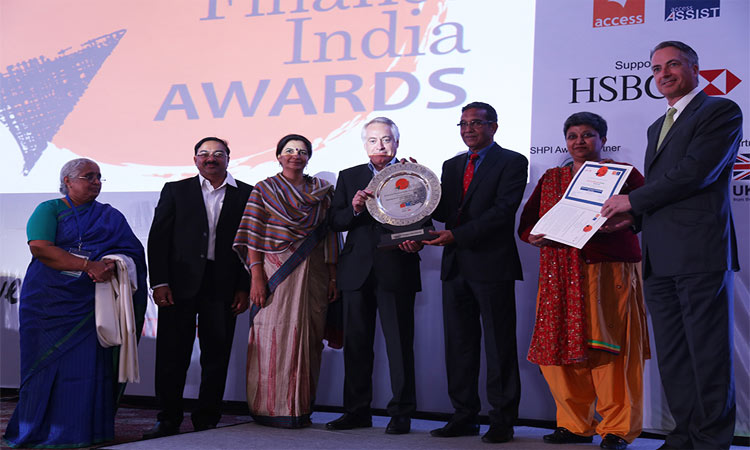
8th Edition of Inclusive Finance India award were presented

8th Edition of Inclusive Finance India award were presented in the conference today. Awards in 8 categories were provided this year to Microfinance Organizations, SHG promoting institutions (SHPIs), Regional Rural Banks (RRBs, lifetime contribution award to an individual and a Jury special award. The awards were given to the following organizations.
Microfinance organization of the year Large – ESAF
Microfinance organization of the year – Small to Medimum: Belstar Investment and Finance Pvt Ltd
SHPI – Large – Lupin
SHPI small – Tamluk Block Mahila Bikash Cooperative Society
RRBs for promoting SHGs: Paschim Banga Gramin Bank
Enabling institution: Ananya Finance for Inclusive Growth
Lifetime contribution: Nandan Nilekani
Jury special award DFID
Other Highlights of the Day:
45% of all loans in the country goes to only 300 borrowers
60% of total savings of indian households are not even in the banking system.
Importance of developing financial literacy content
In the breakaway session on impact linked financing models, the discussion revolved around innovative financial structures in financial institutions, incentive based impact linked financial models and ways to measure success of financial models. The discussants explained their financing models and products in education, housing and health.
Financial awareness and capability building of clients is a key input to achieve financial inclusion. The major goal of communication with clients is objected towards a situation where the clients are able to make an informed choice. Chandani Ohri, CEO, Grameen foundation India started the deliberations with the objective of analyzing methodologies, which can be used at the mass scale for the creation of financial literacy. Santadarshan Sadhu, Research Scientist, University of Chicago; while reiterating the importance of financial awareness said that “Research suggests that financial communication efforts lead to behavioral changes, provided the financial literacy content is well thought of, easy to understand and uses examples from the experience of the clients.” Maya Vengurlekar, Chief Operating Officer, CRISIL foundation emphasized on the importance of developing financial literacy content and channel of communication based on the target group.
Kalpana Sankar, Chairperson and Managing Trustee, Hand in Hand; diverted the attention of the panel towards the low financial literacy score of India and suggested the four step model followed by Hand in Hand for promotion of financial awareness in the fast changing scenario.
Elliot Rosenberg, Vice President, Awaaz.de emphasized the importance of Interactive Voice Response (IVR) in overcoming the barriers of language, literacy and technology. He suggested that the use of customized voice messages focused on the target audience can create a long lasting impact on the clients and will help in bringing about behavioral change.
Ravi Shankar, Head, Bharat Banking, IDFC bank suggested the need to close the gap of availability and awareness. He suggested on the importance of four aspects of communication comprising of where, how when and the most important being who is delivering the communication model.
The third plenary discussed the challenges facing the newly licensed Small Finance Banks following the demonetization. Starting the discussion to put things in perspective Rajiv Lall said “45% of all loans in the country goes to only 300 borrowers, that is how concentrated the asset side of the balance sheet. 81% of entire CASA comes from top 50 centers of the country. 60% of total savings of indian households are not even in the banking system. That is why we have long way to go before we achieve universal financial inclusion” Panelists agreed that given this skew the role of Small Finance Banks become important.
Mr Samit Ghosh and Mr Govind Singh both said that the demonstration had caused minor disruption in the their plans of launching the SFB as their attention has been diverted. In short-term they may face liquidity issues in attracting deposits but in the medium to long-term they see opportunity to mobilize deposits from the low income clients and from a segment which is between low income and middle income segments. Mr Ghosh said that the demonetization had busted the myth that poor did not have savings -just that they keep their savings in cash. “SFBs could tap in to these savings if they are able to address customers’ apprehension regarding the banking system and are able to develop user friendly mechanisms to enable people to open bank accounts and make transactions” said Samit Ghosh of Ujjivan . People who used to save with the chit funds and informal sources could provide huge potential source of funds to the SFBs.
On the asset side there are however concerns as repayment rates have dropped to 70-80%. Mr Samit Ghosh and Mr Govind Singh concurred that they did not expect any change in the credit culture, but if there are disruptions in the livelihoods of clients, there will be negative impact on portfolio quality. Overall impact on the asset quality will however be known only with time. They also agreed that there will be some drop in the growth rates on account of demonetization.
